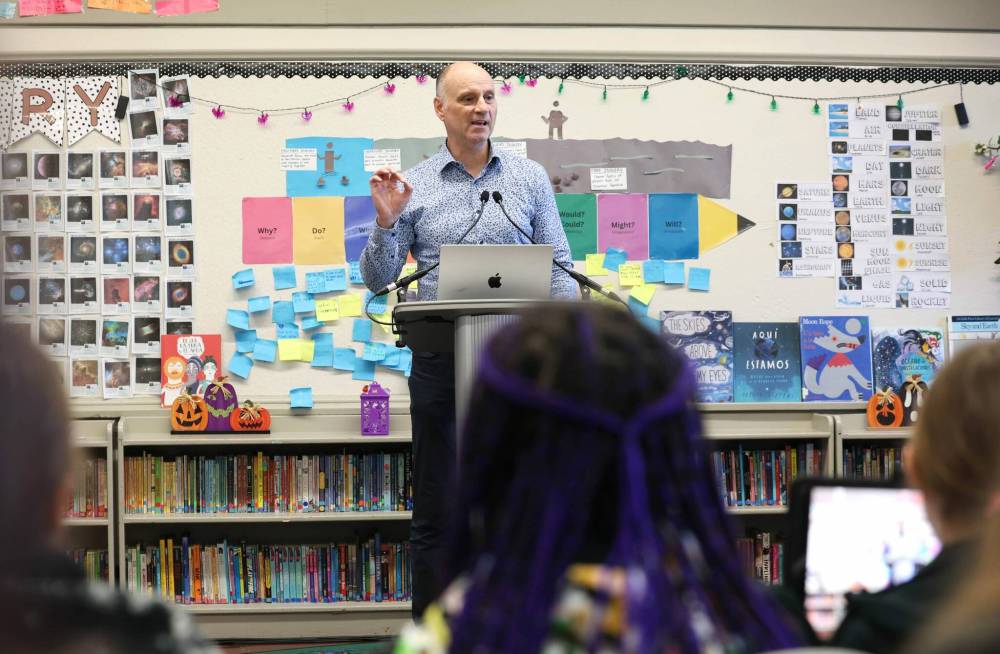Students write next chapter in Free Press media literacy project
Read this article for free:
or
Already have an account? Log in here »
To continue reading, please subscribe:
Monthly Digital Subscription
$0 for the first 4 weeks*
- Enjoy unlimited reading on winnipegfreepress.com
- Read the E-Edition, our digital replica newspaper
- Access News Break, our award-winning app
- Play interactive puzzles
*No charge for 4 weeks then price increases to the regular rate of $19.00 plus GST every four weeks. Offer available to new and qualified returning subscribers only. Cancel any time.
Monthly Digital Subscription
$4.75/week*
- Enjoy unlimited reading on winnipegfreepress.com
- Read the E-Edition, our digital replica newspaper
- Access News Break, our award-winning app
- Play interactive puzzles
*Billed as $19 plus GST every four weeks. Cancel any time.
To continue reading, please subscribe:
Add Free Press access to your Brandon Sun subscription for only an additional
$1 for the first 4 weeks*
*Your next subscription payment will increase by $1.00 and you will be charged $16.99 plus GST for four weeks. After four weeks, your payment will increase to $23.99 plus GST every four weeks.
Read unlimited articles for free today:
or
Already have an account? Log in here »
Manitoba educators and students have a new toolkit to help prepare youth to navigate the tumultuous media world.
On Wednesday, Education Minister Tracy Schmidt, along with delegates from the Winnipeg School Division and the Winnipeg Free Press, formally launched the Media Literacy Resource, an innovative website and teacher-designed learning platform.
First announced in May, the project was developed by a partnership between the provincial education department, the Free Press, and the Winnipeg School Division. The project also received funding from the Winnipeg Foundation. It aims to help students think critically about information, learn how to identify trustworthy sources, and gain hands-on experience by creating their own journalism.

Ruth Bonneville / Free Press
Earl Grey School Students in Grades 4 and 5 in the literacy program look at photos inside the June 2025 edition of the Earl Grey Press Wednesday.
The project marked its public launch with a news conference at Earl Grey School, where many kindergarten to Grade 8 students are in the second year of creating their own monthly newspaper, the Earl Grey Press. (Stay tuned for a deeper look at their effort — and how teachers hope it helps them improve their media literacy skills — in Saturday’s Free Press.)
“I’m really excited about this launch because it really marks another step to empowering kids as informed citizens, as deep thinkers and critical thinkers of our world, and as confident communicators,” said WSD assistant superintendent Shelley Warkentin, speaking to an audience that included many of the young Earl Grey Press reporters.
“It really marks another step to empowering kids as informed citizens, as deep thinkers and critical thinkers of our world, and as confident communicators.”
Through the Media Literacy Resource website at winnipegfreepress.com/education, students and teachers will find guides to study media literacy, and create their own student journalism. Student stories from across the province will be shared on the site, with the potential of some being published in the Free Press.
The first phase of the project, which includes news-building resources for student newspapers, went live to educators across the province this week. Other modules, including bundled teaching resources and a micro-credential program for educators, will be rolled out over the next year.
“I feel like it’s a really good idea, because there have been cases of some people not knowing what to trust,” says 12-year-old River, one of the young Earl Grey Press reporters. He pointed to something Free Press editor Paul Samyn said at the launch, about how the computers of previous generations had a fraction of the power of today’s smartphones.
That comes with immense opportunity, he knows — but also, greater risk.
“So this (Media Literacy Resource) is really good so people don’t end up with false information.”

Ruth Bonneville / Free Press
Paul Samyn, editor of the Winnipeg Free Press, speaks to students in the Earl Grey School literacy Program.
“This (Media Literacy Resource) is really good so people don’t end up with false information.”
As proof, perhaps, that first-hand experience creating journalism helps build confidence, some of the Earl Grey Press kids eagerly spoke up at the news conference to question Schmidt about goals for the resource, along with other local education topics.
“We know that kids are very smart, but it’s also our job as your government, as your teachers, as your school, and as your community to help you become smarter, and safer, and more responsible when you’re using technology and reading news online,” Schmidt told them.
“We want you to feel confident that when you’re learning and when you’re sharing, when you’re talking about what’s happening in the world today, that you have the skills to do that. So this is a very exciting day, but guess what? This is just the beginning.”
melissa.martin@freepress.mb.ca

Melissa Martin
Reporter-at-large
Melissa Martin reports and opines for the Winnipeg Free Press.
Every piece of reporting Melissa produces is reviewed by an editing team before it is posted online or published in print — part of the Free Press‘s tradition, since 1872, of producing reliable independent journalism. Read more about Free Press’s history and mandate, and learn how our newsroom operates.
Our newsroom depends on a growing audience of readers to power our journalism. If you are not a paid reader, please consider becoming a subscriber.
Our newsroom depends on its audience of readers to power our journalism. Thank you for your support.



